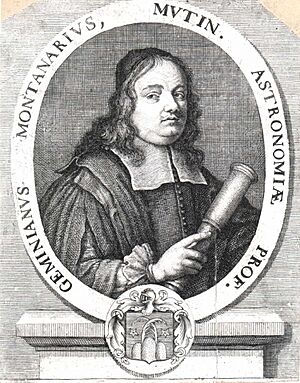Geminiano Montanari facts for kids
Quick facts for kids
Geminiano Montanari
|
|
|---|---|
 |
|
| Born | 1 June 1633 Modena, Duchy of Modena and Reggio
|
| Died | 13 October 1687 (aged 54) |
| Nationality | Italian |
| Alma mater | University of Salzburg |
| Known for | Discovery of the variations in brightness of Algol |
| Scientific career | |
| Fields | |
| Institutions | |
| Notable students |
|
Geminiano Montanari (born June 1, 1633 – died October 13, 1687) was an Italian astronomer. He also made lenses and believed strongly in learning through experiments. He was part of several important science groups, like the Accademia dei Gelati. Some of Montanari's well-known students included Domenico Guglielmini and Luigi Ferdinando Marsili.
He is most famous for something he noticed around 1667. He saw that Algol, the second-brightest star in the Perseus constellation, changed how bright it was. This type of star is called a variable star. Others might have seen this before, but Montanari was the first astronomer to write it down. The name Algol comes from Arabic and means "ghoul" or "demon". This suggests people might have noticed its strange behavior a long time ago.
Contents
Geminiano Montanari's Life
Montanari was born in Modena, Italy, on June 1, 1633. His father passed away when Geminiano was only ten years old. He started his studies in Modena. When he was twenty, he moved to Florence to study law, staying there for three years. In Florence, he helped observe the phases of Saturn after Christiaan Huygens published his book Systema Saturnium.
In 1656, Montanari left Florence and went to Salzburg, Austria. He earned his law degree there that same year. With help from Paolo del Buono, a friend of Galileo Galilei, Montanari continued his math studies. He had started these studies in Modena when he was thirteen.
Working as a Scientist
In early 1661, Montanari became a philosopher and mathematician for the court in Modena. Around this time, he met Marquis Cornelio Malvasia. Malvasia was an important supporter of science in Bologna. He had built an observatory at his home near Modena. Montanari helped Malvasia finish his book Ephemerides.
After the death of Alfonso IV d'Este, Duke of Modena in 1662, Montanari left the Modena court. He continued his astronomy studies with Malvasia's support. Malvasia also helped Montanari get a job teaching mathematics at the University of Bologna. Montanari started teaching there in December 1664.
Discoveries and Observations
In Bologna, Montanari created a very detailed map of the Moon. He used a special tool he invented called an ocular micrometer. He also studied how liquids behave, like capillarity (how liquids move in narrow spaces). He thought that how thick a liquid was (its viscosity) depended on the shape of its tiny molecules.
In 1665, Montanari started a science group called the Accademia della Traccia. This group later became the Academy of Sciences of the Institute of Bologna. The meetings were first held at a friend's house, then at Montanari's home for many years.
Montanari loved watching the sky. He observed a bright meteor that flew across Italy on March 21, 1676. He also watched the comet of 1682, which was the same one Edmond Halley observed. Isaac Newton even mentioned Montanari's observations of the great comet of 1680 in his famous book, Philosophiæ Naturalis Principia Mathematica.
Montanari also wrote books to show that astrology (predicting the future using stars) was not real science. In 1675, he played a trick by writing an astrology book completely by chance. He wanted to show that random predictions were just as likely to come true as those made by astrologers. After Galileo's time, scientists like Montanari focused on experiments. They often disagreed with more mystical ideas from other thinkers. Montanari believed in keeping science separate from beliefs about the universe.
In July 1678, Montanari was given a new teaching job in astronomy and meteorology at the University of Padua. He also wrote about economics, which is the study of how money and goods are made and used. He noticed that the need for a product was set. He also wrote about coins and the value of money in 1683.
A crater on the Moon is named after him. It is located at 45.8S, 20.6W.
Ideas on Money and Value
Geminiano Montanari is known in the study of economics for his two books about coins. He wrote them around 1680. In these books, Montanari openly criticized wrong ideas about coins in his time. He explained how changing the value of coins could be harmful. He also shared rules for making money at mints.
His studies on money led him to think about the idea of "value." He disagreed with the idea that gold and silver always had the same value compared to each other. He believed that the value of something depended on how rare it was. But he meant "rare" in relation to how much people wanted it (the demand).
Montanari was able to explain many general ideas about value. However, the topic of the value of money itself is very complex.

